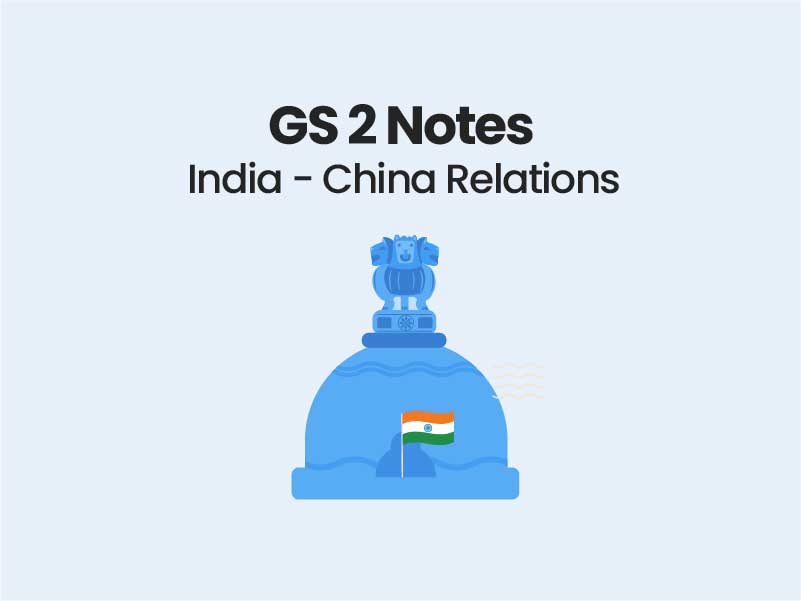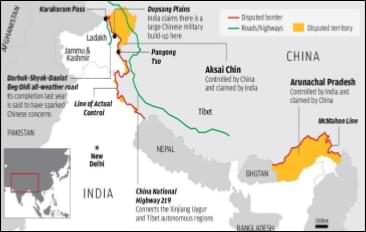Companion@360 → 7 Month programme to sharpen your writing skills → REGISTER NOW
- Phone 8138 000 360
- WhatsApp 8138 000 360
- Telegram Channel t.me/civils360


India – China Relations
- January 2, 2022
- International Relations , Notes

China and India are both ancient civilisations and major developing countries. As the only two major developing countries and important representatives of emerging economies, China-India relations assume global and strategic significance.
India-China Relation – Background
- In 1950, India became the first non-socialist bloc country to establish diplomatic relations with the People’s Republic of China.
- The two countries also jointly expounded the Panchsheel (Five Principles of Peaceful Coexistence) in 1954.
- Though the border conflict in 1962 was a serious setback to bilateral ties, India and China restored ambassadorial relations in August 1976.
- Indian PM Rajiv Gandhi’s landmark visit in 1988 marked the beginning of improvement in bilateral relations.
- In 1993, the signing of an Agreement on the Maintenance of Peace and Tranquillity along the Line of Actual Control on the India-China Border Areas reflected the growing stability in bilateral ties.
- Signed the Declaration on Principles for Relations and Comprehensive Cooperation in 2003 and mutually decided to appoint Special Representatives (SRs) to explore the framework of a boundary settlement.
- In 2005, the two sides established a Strategic and Cooperative Partnership for Peace and Prosperity.
- India-China bilateral relations have expanded and become diversified in the past decade
- In 2014, the two sides redefined the bilateral engagement as Closer Developmental Partnership.
- 2020 marked the year of the 70 th anniversary of the establishment of diplomatic relations between China and India
Both the countries have similar attributes and problems including large population, huge rural-urban divide, rising economy and conflict with neighbours. India and China have established several dialogue mechanisms at various levels, covering bilateral political, economic, cultural, people-to-people, consular matters as well as dialogues on regional and global issues.
However, India-China relationship is dotted with “competition, cooperation, and discord”. In the past few years, these played out in incidents like India’s critique of China’s Belt and Road Initiative (BRI), India’s entry into the Shanghai Cooperation Organisation (SCO), the dramatic crisis in Doklam & Galwan Valley, the acceleration of multilateral cooperation in the BRICS and attempts to foster economic engagement.

Areas of Cooperation
- There are 50 dialogue mechanisms between China and India for exchanging views on various topics of bilateral, regional, and global concern.
- China is India’s largest goods trading partner , whereas India is the 12 th largest trading partner of China.
- E-business visa – has been introduced in 2017 to encourage more number of business persons from China travelling to India
- Indian companies have set up IT corridors in China, which help promote China-India cooperation in information technology and high technology
- China-India defense and security consultation to strengthen exchanges and cooperation in the defense field.
- The two countries have established pairs of sister cities and provinces. For example, sister provinces and cities between Fujian Province & Tamil Nadu State, Quanzhou City & Chennai City.
Education relations – India and China signed the Education Exchange Programme (EEP) in 2006, which is an umbrella agreement for educational cooperation, providing scholarships for students.
Areas of Contention
- Belt and Road Initiative (BRI) – India boycotted BRI on issues of sovereignty (as China-Pakistan-Economic-Corridor – part of BRI, passes through Pakistan Occupied Kashmir) and other concerns over transparency, debt burden issues.
- Increasing presence in Indian Ocean (String of Pearls) – Chinese policy of building ports and naval bases around India’s maritime reaches such as Cocos Island in Myanmar, Chittagong in Bangladesh, Hambantota (Sri Lanka), Marao Atoll (Maldives) and Gwadar (Pakistan) is seen as Chinese encirclement of India

- Western Sector (Ladakh) – India uses Johnson Line and claims Aksai Chin as its own. China do not recognise it and instead accepts McDonald Line which puts Aksai Chin under its control.
- Middle Sector (Himachal Pradesh and Uttarakhand) – Here LAC is the least controversial except for the precise alignment to be followed in the Barahoti plains. India and China have exchanged maps on which they broadly agree
- Eastern Sector (Arunachal Pradesh and Sikkim) – dispute is over the McMahon Line (in Arunachal Pradesh) decided in 1914 in a meeting of Representatives of China, India, and Tibet in Shimla.
- India has objected to it but there has been no formal treaty over sharing of the Brahmaputra water.
- Dalai Lama and Tibet issue – India supports a Tibetan government in exile formed by Dalai Lama which is unacceptable to China.
- Presence in South Asia – China has been increasing investments, enhancing trade with countries in South Asia challenging India’s traditional position in the neighbourhood.
- China’s protectionist policies – hinder the ability of Indian companies to enter Chinese markets.
- China’s Support to Pakistan – Through investments (e.g., CPEC), and supporting Pakistan on various issues like on Kashmir in UNSC, on terrorism, on NSG etc. has emboldened Pakistan to continue its policy of asymmetric warfare against India.
- Nuclear Suppliers Group ( NSG ) – China has been blocking India’s attempt to entry to NSG to build a case for Pakistan.
- Chinese company Huawei has been boycotted by many countries including the USA citing privacy issues. India still lacks any strong framework that can address such security issues.
Read Full GS Notes
Leave a Reply Cancel Reply
Your email address will not be published. Required fields are marked *
Name *
Email *
Add Comment *
Save my name, email, and website in this browser for the next time I comment.
Post Comment

IMAGES
VIDEO
COMMENTS
India-China Relation – Background. In 1950, India became the first non-socialist bloc country to establish diplomatic relations with the People’s Republic of China. The two countries also jointly expounded the Panchsheel (Five Principles of Peaceful Coexistence) in 1954. Though the border conflict in 1962 was a serious setback to bilateral ...
The Indo-Pacific is one area where India is becoming more of a factor in China’s foreign policy making since 2017 because of its association with America. 118 Some scholars have recently averred that China has made up its mind that India will lean toward the United States, and China will be the object of containment. 119 There are others who ...
India-China Relations: Reset Needed in 2018. There is a systematic buildup of negative images of how each side viewed the other’s foreign policies along with a collapse in geopolitical trust. China’s attempt to raise its economic and political profile in the subcontinent was seen as a challenge to India’s authority in the region.